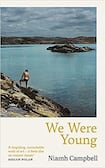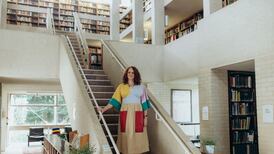
In This Happy, Niamh Campbell’s widely shortlisted 2020 debut, a 30-year-old woman recalls an affair she had in her early 20s with a man in his 40s. Now married to a 40-year-old, the woman recognises the “extreme melancholy and longing which overtakes” middle-aged men, “and which they always believe to be original”.
We Were Young takes up the thread by tracking a man on the cusp of middle age, caught between the competing drives for freedom and intimacy. Cormac, a bisexual photographer and lecturer, is single and trying to stave off the trappings of middle age with casual sex and drugs. His ex, Ava, a well-known choreographer, is now married to a producer and “has a child, a trampoline probably – he imagines it silvered with dewdrops as the sun crowns over the gardens of suburbia”.
Cormac’s banker brother, Patrick, meanwhile, is confronting his own midlife crisis, with his marriage strained by his drinking. Cormac fields late-night calls from Patrick’s worried wife, culminating in an intervention. Cormac sees his brother’s choice of profession as a kind of class betrayal: “He has known Patrick all his life – but time and ascension into identities have made them strange.” Both men are haunted by the loss of their brother Thomas in their youth.
Immersive experience
The novel opens at an immersive theatre experience about the Magdalene laundries, where Cormac panics as he tries not to get aroused by a naked actor in a bathtub: “Why did they have to choose an actress with a taut, sexy body? Is that really necessary? Are you supposed to ignore that?” He starts to date Caroline, a dancer he meets at the play. They’re both keen, but his resistance to commitment scuppers any chance of connection. Like at the theatre, Cormac prefers to hang back rather than get involved. Relationships, he believes, are destined to decay –“mysteriously, but inevitably”.
In addition to Caroline, Cormac is enmeshed with other lovers, both female and male, with whom he slips in and out of intimacy. The sex scenes proceed calmly, with Campbell more likely to notice the quality of light than the shifting geometries of the bodies: “There was a huge halfmoon outside the window as they f**ked.” I was less convinced by the drug interludes of characters taking MDMA and mushrooms. (Trips are notoriously tricky to capture in writing, as altered states of consciousness are largely ineffable.)
Among Cormac’s lovers is Nina, a painter and former student. Like Caroline, she wants a relationship with Cormac, but when she suggests they “make it real”, he falls silent. “Nothing he could say would approach what she wanted to hear.” There’s a pleasing parallel with Campbell’s 2020 Sunday Times Audible Short Story Award-winning Love Many, in which she delicately depicts a similar situation from the woman’s perspective. Campbell’s young female characters are more mature than the men they date. Still, she considers Cormac with compassion.
Acute self-consciousness
There is much to admire about We Were Young, which wryly captures the dynamics of art circles in post-Celtic Tiger Dublin and the acute self-consciousness of our time. Campbell writes beautiful sentences with breathtaking imagery. In a comment that could easily be applied to her writing, Cormac says of his photography, “It comes down to atmospheres – trying to decant and describe atmospheres”, adding: “This is life.” Is it, though? Our minds are meaning-making machines, and without a narrative arc to anchor it, the atmospheric quality of the novel feels ephemeral. The drama of This Happy was also largely internal, but its device of retrospection allowed readers to witness the heroine’s maturation.
“Entrapment in eternal adolescence has long been a condition of making art,” Campbell wrote in a Guardian essay. The Peter Pan archetype is embedded in our mythologies, the puer aeternus dating back to Ovid’s Metamorphoses. But as the New Yorker critic Katy Waldman has observed, while the coming-of-age novel (even if it’s coming-of-middle-age) traditionally involved growth, today’s practitioners tend to “halt the journey midway through, leaving their characters tuned to problems but unable to solve them”.
Cormac admits that his life lacks meaning but is unwilling or unable to shift the blocks to intimacy. This gap could evoke pathos: “What a weary time those years were – to have the desire and the need to live but not the ability,” wrote Charles Bukowski, a precursor Peter Pan, in his metafictional Ham on Rye. Instead, the point of view shifts to Nina, nursing heartbreak and struggling to paint at an artist’s retreat on the coast. Her decision to get to work is a feminist coda of sorts. But by keeping the protagonist a lost boy, We Were Young, like Cormac’s art, never quite transcends its “world of surfaces”.









